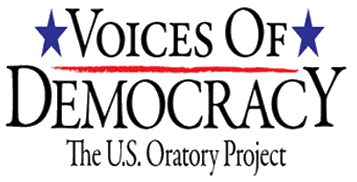DWIGHT D. EISENHOWER, “ATOMS FOR PEACE” (8 DECEMBER 1953)
Classroom Activities
- President Eisenhower repeatedly describes the “privilege” of addressing the U.N. General Assembly. Why do you think he does that? What does doing so suggest about his character? What effects might his doing so have had on his audience
- What can you infer about the audience by specific choices President Eisenhower and his writers have made in the speech? (For example, what might it say about the audience when Eisenhower says that he has “a sense of exhilaration” as he looks “upon this assembly”?
- Listen to historian Douglas Brinkley’s report on Eisenhower’s “Farewell Address to the Nation,” from National Public Radio’s “Weekend Edition Sunday” on Jan. 14, 2001 (http://www.npr.org/templates/story/story.php?storyId=1117038). How does hearing what Brinkley calls “Eisenhower’s uninspiring, plain Kansas drawl” change the way you think about his “Atoms for Peace” speech? What is the relationship between “hope” and “fear” in his final address as president–a speech Brinkley repeatedly refers to as a “warning”?
- Review the following materials from these websites: Mitchell B. Reiss’s assessment of the “Atoms for Peace: A Future After Fifty Years?” U.S. Department of State, 2003, http://2001-2009.state.gov/s/p/rem/2003/27035.htm; and “Atoms for Peace +50: Nuclear Energy and Science for the 21st Century,” Institute for Foreign Policy Analysis, http://www.ifpa.org/pdf/DOEFlet.pdf.
- How is Eisenhower’s Atoms for Peace campaign remembered some sixty years after it commenced? How are President Eisenhower’s contributions to the development of atomic energy and weaponry likewise remembered?
- Identify and discuss President Eisenhower’s use of metaphors in the speech. How do his metaphors differ in relation to the Soviet Union versus the United States and its allies? Why do you think that he used nature metaphors to talk about atomic energy development? Do such nature metaphors represent a strategic choice for President Eisenhower? Why or why not?
- Assess President Eisenhower’s use of evidence in the speech? What kinds of proof does he use? Do you find such evidence sufficient or effective?
Student Research
- When was the United Nations founded–and why? Use two different research tools, one print source and one electronic database, to learn about the history of the United Nations.
- In speaking about atomic warfare, Eisenhower says he is speaking “in a language that, in a sense, is new.” Using a good reference dictionary–the Oxford English Dictionary is the best–look up the word “atomic” and prepare to discuss the legitimacy of Eisenhower’s claim about a “new” language.
- How does the end of the Korean War figure in Eisenhower’s speech? Use three different research tools–one conversation, one print source, and one electronic database–to learn about the Korean War; then prepare to discuss how that war provided part of the context for Eisenhower’s speech.
- Write a research paper on the Eisenhower administration’s New Look strategy. Consider how the New Look strategy differed from or re-enforced the Truman administration’s conceptions of atomic weaponry.
- Compare and contrast Eisenhower’s “Atoms for Peace” speech to Eisenhower’s “Farewell Address.” Note the similarities and differences between the two speeches in relation to Eisenhower’s conceptions of atomic capability and development.
- Eisenhower’s speech mentions an “international atomic energy agency.” Did such an agency exist at the time or was it created in response to the speech? Review the IAEA’s current website to assess the organization’s remembrance of the Atoms for Peace campaign: http://www.iaea.org/.
- Locate newspaper stories about the Atoms for Peace speech soon after it was delivered? What did journalists write about the speech?
Citizenship Resources
- Locate two sources (one print and one electronic) that detail contemporary attitudes toward the United Nations. In what ways are attitudes toward the U.N. different or similar to those views articulated in Eisenhower’s “Atoms for Peace” speech?
- Find and watch President George W. Bush’s Sept. 23, 2003, address to the U.N. General Assembly (http://www.c-span.org/video/?178315-1/general-assembly-meeting) or find and read a transcript of that speech (http://www.un.org/webcast/ga/58/statements/usaeng030923.htm). Compare and contrast–in a piece of writing or an impromptu speech–Eisenhower’s speech with Bush’s.
- What do President Bush’s comments about “weapons of mass destruction” have in common with President Eisenhower’s “new” language of atomic warfare? How are their uses of the two phrases different? See how much you can find out about the phrase “weapons of mass destruction.” When did the phrase originate for example? Who first used it?
- Remembering the contrast of “hope” and “fear” in President Eisenhower’s speech, find other public discourse that contrasts hope with fear. What contemporary political topics involve a public’s ability to overcome fear with hope?
- Listen to Daniel Schorr’s commentary that aired on National Public Radio’s “Weekend Edition Sunday” on Dec. 30, 2001, (http://discover.npr.org/features/feature.jhtml?wfId=1135572). In his speech, President Eisenhower asserted that “the dread secret, and the fearful engines of atomic might, are not ours alone”; Schorr’s commentary suggests how nuclear weapons have continued to affect global politics since Eisenhower’s “Atoms for Peace” campaign. In addition to the United States, the former Soviet Union, India, and Pakistan, what other nations are now “nuclear powers”?
- President Eisenhower’s “Atoms for Peace” speech suggests that atomic energy has an important role to play in the future of the United States and the world. Find out what you can about atomic, or nuclear, energy–how it works; where it is produced; how many states and countries produce and use it–and come to some opinion of whether nuclear energy has met Eisenhower’s hope for its promise. If you decide it has not, prepare to talk about why.
Teaching Strategies prepared by Rosa A. Eberly, Pennsylvania State University and Shawn J. Parry-Giles, University of Maryland
Last updated April 27, 2016.

